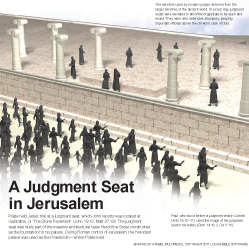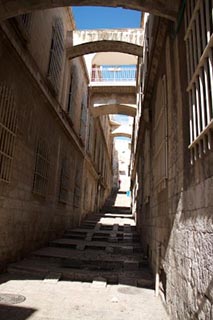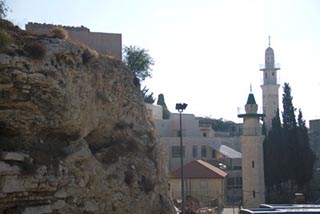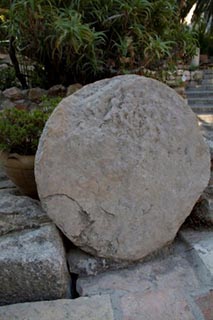27:1–2 As the day dawns, the religious leaders take Jesus to Pilate to be sentenced. |
27:1 took counsel against Jesus The assembly had decided overnight to condemn him (26:17–68); this was a more formal gathering.
27:2 handed him over to Pilate Roman governor of Judaea. Only Roman authorities could impose the death penalty (John 18:31).
Little is known of this Roman governor |
27:3–10 Recognizing his guilt in Jesus’ death sentence, Judas |
27:5 throwing the silver coins into the temple A parallel to Zech 11:13.
he went away and hanged himself Compare Acts 1:18 and note.
27:7 burial place for strangers The plot was a burial place for Gentiles who died while in Jerusalem and its surrounding area. Gentiles could not be buried with Jews.
place for Gentiles who died while in Jerusalem and its surrounding area. Gentiles could not be buried with Jews.
27:8 Field of Blood See Acts 1:19 and note.
27:9 spoken by the prophet Jeremiah The reference to the potter and 30 pieces of silver comes from Zech 11:12–13; the allusion to a business transaction appears to reflect Jer 32:6–9. Thirty pieces of silver is also the price someone owed if their ox killed a slave (Exod 21:32).
 Jesus’ Fulfillment of Old Testament Prophecy Table
Jesus’ Fulfillment of Old Testament Prophecy Table
27:11–26 The religious leaders hand Jesus over to Pilate. Jesus, however, does not respond to the fabricated charges brought against Him (compare Isa 53:10 and note). Apparently wanting to free Jesus, Pilate offers to release a prisoner, but the crowd calls for Barabbas instead of Jesus. In order to prevent a riot, Pilate submits to the crowd’s wishes and hands Jesus over to be crucified. |
27:11 Are you the king of the Jews In addition to the religious reasons of the scribes and Pharisees, the Romans wanted Jesus killed because of political concerns. The Roman government did not tolerate rebellion against the empire. Compare Isa 52:15 and note.
27:15 release one prisoner to the crowd This custom is not attested outside the Bible.
27:16 Jesus Barabbas The other Gospels identify Barabbas as a violent insurrectionist (Mark 15:7; Luke 23:19; John 18:40).
as a violent insurrectionist (Mark 15:7; Luke 23:19; John 18:40).
27:18 they had handed him over because of envy The situation pits Pilate against the Jews and their religious leaders: If Pilate sides with Jesus and releases Him, he likely will have to contend with a riot and disfavor from Rome for mismanaging the situation. If he submits to the Jews, he avoids a riot, but condemns an innocent man to death.
27:19 the judgment seat An elevated bench that allowed Pilate to be heard over the crowd.
dream In writings from this period, dreams were common means of supernatural revelation.
27:20 persuaded the crowds Probably residents of Jerusalem, not the Galilean peasants who had hailed Jesus as Messiah (compare Matt 21:8–11).
27:22 Let him be crucified The cries of the crowd correspond with Jesus’ prediction about His death (see 20:19).
27:24 instead an uproar was developing The Passover festival had brought crowds of people—and the threat of riots—to Jerusalem. See 26:5 and note.
took water and washed his hands An act signifying absolution, although technically as governing authority, Pilate is still partly responsible.
27:25 on us and on our children The Jewish leaders who oppose Jesus are partly responsible for His death. Despite the crowd’s rash statement in v. 25, this does not amount to culpability for an entire nation or people group. In addition, Isa 52:10, as well as Jesus’ own words (Matt 16:21), indicate that Jesus’ death was ultimately God’s decision, for the salvation of humanity.
27:26 flogged Refers to being beaten with whips, which often contained bits of bone, rock, and metal to flay the skin. Jesus predicted this would happen to Him (see Matt 20:19).
with whips, which often contained bits of bone, rock, and metal to flay the skin. Jesus predicted this would happen to Him (see Matt 20:19).
27:27–44 After beating and mocking Jesus, Roman soldiers take Him outside the city and crucify Him. While He is hanging on the cross, the Jewish leaders and others ridicule Him. |
27:27 the whole cohort Consists of 600–1,000 soldiers. They probably were stationed in Jerusalem to provide extra security during the Passover festivities (see Matt 26:5 and note).
27:28 scarlet The color of royalty.
27:29 crown A mock crown for one perceived to be a mock king; also likely a means of torture. The royal robe and reed scepter also are intended to ridicule Jesus, who predicted that He would be mocked (see 20:19).
27:32 a man of Cyrene named Simon Cyrene was on the Mediterranean Sea in North Africa. Simon’s reason for being in Jerusalem is unknown, but he might have been a Jewish pilgrim. Apparently, his sons became well-known in the early church (see Mark 15:21).
They forced this man to carry his cross See note on Mark 15:21.
27:33 Golgotha An Aramaic word meaning “skull.”
Place of a Skull The Latin word for “skull” is calvaria, from which the English word Calvary derives.
27:34 wine mixed with gall Meant to mitigate the pain (see Psa 69:21).
27:35 crucified him Jesus had predicted this manner of death (Matt 20:19).
divided his clothes among themselves by casting lots A parallel to Psa 22:18. Compare Isa 53:3 and note.
27:37 This is Jesus, the king of the Jews The placard identified the charge against Jesus, declaring Him a messianic pretender and a political threat to Rome. Ironically, this sign proclaims Jesus’ true identity.
27:38 two robbers They may have been thieves or insurrectionists (Matt 26:55; 27:44). See Isa 53:12.
27:39 reviled him See Pss 22:6–7; 109:25; Lam 2:15; Jer 18:16.
27:43 let him deliver him Compare Psa 22:8.
I am the Son of God The religious leaders assume that God would not let His Son be executed. Compare Isa 53:12 and note.
27:45–56 Jesus dies for the sin of the world. The significance of His death is conveyed through supernatural occurrences. |
27:45 darkness came over all the land Likely represents divine disfavor over the imminent death of the Messiah. The Greek text says the darkness lasted from the sixth hour to the ninth hour. The first hour of the day was 6 a.m., so the period of darkness was noon to 3 p.m.
27:46 My God, my God, why have you forsaken me Jesus quotes the opening line of Psa 22, which closely parallels the events of Jesus’ suffering and death (see note on Psa 22:1).
27:47 This man is summoning Elijah Jesus’ cry (in Aramaic) sounds like the name of the prophet.
27:48 filled it with sour wine To dull the pain or quench the thirst (Psa 69:21).
27:50 gave up his spirit An idiom meaning “died.”
27:51 curtain of the temple was torn Perhaps symbolizing unrestricted access to God—no longer mediated by the temple and its sacred space (see note on Mark 15:38; compare Exod 26:31–35; Heb 6:19–20; 10:20). This concept would be important for Matthew’s audience, particularly if he compiled his Gospel after the Romans destroyed the temple in ad 70.
The temple had many curtains, and the text does not specify which was torn. It likely refers to the curtain that separated the courts from the sanctuary or the curtain between the holy place and the most holy place.
from top to bottom The direction of the tear—along with the passive verb—implies an act of God.
27:52 the tombs were opened This detail is unique to Matthew. Apparently, following Jesus’ resurrection, the saints entered Jerusalem as a demonstration of God’s resurrecting power.
27:53 coming out of the tombs after his resurrection See v. 52 and note.
27:54 Truly this man was God’s Son This conclusion seems to be based on the phenomena surrounding Jesus’ death (earthquake, unnatural darkness, etc.). As elsewhere in Matthew, a Gentile rightly identifies Jesus while the Jews remain unaware.
27:56 Mary Magdalene According to Luke, Mary was a follower of Jesus from whom he had cast out seven demons (Luke 8:2).
Mary the mother of James and Joseph This could be Jesus’ mother, His aunt, or another Mary not mentioned elsewhere in the Gospels (compare Mark 6:3; 15:40; John 19:25).
mother of the sons of Zebedee The mother of James and John, Jesus’ disciples.
27:57–61 Joseph of Arimathea receives Jesus’ body and provides a proper burial. The religious leaders place guards at the tomb to prevent Jesus’ disciples from stealing His body. |
27:57 rich man from Arimathea named Joseph Arimathea was about 20 miles northwest of Jerusalem. It was the birthplace of the prophet Samuel (Ramathaim; 1 Sam 1:1). Compare Isa 53:9 and note.
who also was a disciple of Jesus The other Gospels identify Joseph as a member of the Jewish ruling council, the Sanhedrin (Mark 15:43; Luke 23:50; John 19:38).
27:58 asked for the body Without Joseph’s intervention, Jesus likely would have been buried with executed criminals or discarded on a trash heap. Under Jewish law, the corpse needed to be buried the same day or the land would be defiled (Deut 21:22–23).
27:60 rolled a large stone to the entrance The rock probably was leveraged into a shallow trough in front of the tomb’s opening. Rolling it into place would have been significantly easier than rolling it back.
27:62 chief priests Prominent priests who were involved in Jewish religious government.
Pharisees See note on John 1:24.
27:63 After three days I will rise See Matt 16:21; 17:23; 20:19.
27:64 the last deception will be worse than the first In the minds of the Jewish leaders, a potential claim of Jesus’ resurrection would be worse than His claim to be the Messiah.
27:66 by sealing the stone Refers to pressing wax or clay between the stone and the tomb entrance and then stamping it with an imperial insignia (see Dan 6:17 and note.)

|
About Faithlife Study BibleFaithlife Study Bible (FSB) is your guide to the ancient world of the Old and New Testaments, with study notes and articles that draw from a wide range of academic research. FSB helps you learn how to think about interpretation methods and issues so that you can gain a deeper understanding of the text. |
| Copyright |
Copyright 2012 Logos Bible Software. |
| Support Info | fsb |
 Loading…
Loading…
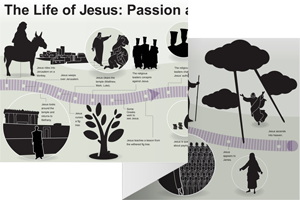

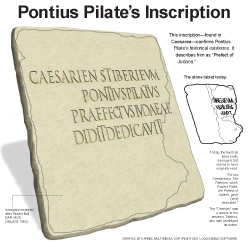
 Pilate
Pilate 